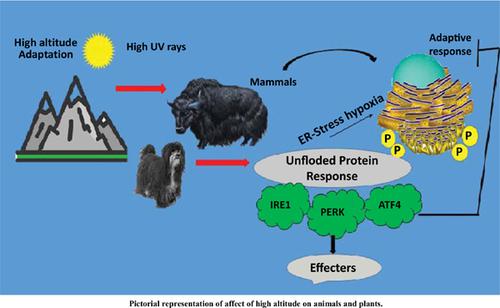Current Proteomics ( IF 0.8 ) Pub Date : 2021-07-31 , DOI: 10.2174/1570164617999201002144747 Asma Babar 1 , Kifayatullah Mengal 1 , Abdul Hanan Babar 2 , Shixin Wu 1 , Mujahid Ali Shah 1 , Chuanfei Xu 1 , Xuegang Luo 1 , Xin Cai 1

|
The world's highest and largest altitude area is called the Qinghai-Tibetan plateau QTP, which harbors unique animal and plant species. Mammals that inhabit the higher altitude regions have adapted well to the hypoxic conditions. One of the main stressor at high altitudes is hypoxia. Metabolic responses to hypoxia play important roles in cell survival strategies and some diseases. However, the homeostatic alterations that equilibrate variations in the demand and supply of energy to maintain organismal function in a prolonged low O2 environment persist partly in understood, making it problematic to differentiate adaptive from maladaptive responses in hypoxia. Tibetans and yaks are two perfect examples innate to the plateau for high altitude adaptation. By the scan of the whole-genome, EPAS1 and EGLN1 were identified as key genes associated with sustained hemoglobin concentration in high altitude mammals for adaptation. The yak is a much more ancient mammal that has existed on QTP longer than humans. It is, therefore, possible that natural selection represented a diverse group of genes/pathways in yaks. Physiological characteristics are extremely informative in revealing molecular networks associated with inherited adaptation, in addition to the whole-genome adaptive changes at the DNA sequence level. Gene-expression can be changed by a variety of signals originating from the environment, and hypoxia is the main factor amongst them. The hypoxia-inducible factors (HIF-1α and EPAS1/HIF-2α) are the main regulators of oxygen in homeostasis, which play a role as maestro regulators of adaptation in the hypoxic reaction of molecular mechanisms. The basis of this review is to present recent information regarding the molecular mechanism involved in hypoxia that regulates candidate genes and proteins. Many transcriptional responses toward hypoxia are facilitated by HIFs that change the number of gene expressions and help in angiogenesis, erythropoiesis, metabolic reprogramming, and metastasis. HIFs also activate several signals highlighting a strong association between hypoxia, the misfolded proteins’ accumulation in the endoplasmic reticulum in stress, and activation of Unfolded Protein Response (UPR). It was observed that at high-altitudes, pregnancies yield a low birth weight 100 g per1000 m of the climb. It may involve variation in the events of energy-demand, like protein synthesis. Prolonged hypobaric hypoxia causes placental ER stress, which, in turn, moderates protein synthesis and reduces proliferation. Further, Cardiac hypertrophy by cytosolic Ca2+ raises and Ca2+/calmodulin, calcineurin stimulation, NF-AT3 pathway might be caused by an imbalance in Sarcoplasmic reticulum ER Ca2+, which might be adaptive in the beginning but severe later on.
中文翻译:

高海拔缺氧
世界上海拔最高、海拔最大的地区被称为青藏高原青藏高原,这里蕴藏着独特的动植物物种。栖息在高海拔地区的哺乳动物已经很好地适应了缺氧条件。高海拔地区的主要压力源之一是缺氧。对缺氧的代谢反应在细胞存活策略和一些疾病中起着重要作用。然而,平衡能量需求和供应变化的稳态改变,以在长时间的低 O 2环境部分在理解中持续存在,这使得区分缺氧条件下的适应性和适应不良反应存在问题。藏族和牦牛是高原天生适应高海拔的两个完美例子。通过全基因组扫描,EPAS1 和 EGLN1 被确定为与高海拔哺乳动物持续血红蛋白浓度相关的关键基因。牦牛是一种更古老的哺乳动物,在 QTP 上的存在时间比人类更长。因此,自然选择可能代表了牦牛的一组不同的基因/途径。除了 DNA 序列水平的全基因组适应性变化外,生理特征在揭示与遗传适应相关的分子网络方面非常有用。来自环境的各种信号可以改变基因表达,其中缺氧是主要因素。缺氧诱导因子(HIF-1α和EPAS1/HIF-2α)是体内平衡氧的主要调节因子,在分子机制的缺氧反应中起适应的主要调节因子的作用。本综述的基础是介绍有关缺氧调节候选基因和蛋白质的分子机制的最新信息。许多针对缺氧的转录反应是由 HIF 促进的,HIF 会改变基因表达的数量,并有助于血管生成、红细胞生成、代谢重编程和转移。HIFs 还激活了几个信号,突出了缺氧、内质网中错误折叠的蛋白质在压力下的积累之间的强烈关联,和激活未折叠蛋白质反应 (UPR)。据观察,在高海拔地区,每爬升 1000 米,孕妇的出生体重会降低 100 克。它可能涉及能量需求事件的变化,如蛋白质合成。长时间的低压缺氧会导致胎盘内质网应激,进而减缓蛋白质合成并减少增殖。此外,细胞质 Ca 引起的心脏肥大2+升高和Ca 2+ /钙调蛋白、钙调神经磷酸酶刺激、NF-AT3 通路可能是由肌浆网ER Ca 2+失衡引起的,这种失衡可能在开始时是适应性的,但后来很严重。



























 京公网安备 11010802027423号
京公网安备 11010802027423号